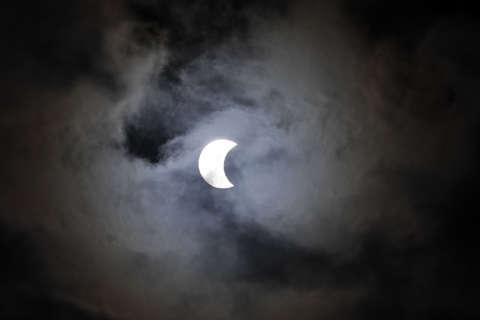WASHINGTON — Unless you’re old, it’s safe to say you haven’t had many chances to practice photographing eclipses.
After all, the last total solar eclipse viewed from the contiguous U.S. was in 1979.
Yes it’s not fair, but cheer up. You still have some time to prepare and get a good shot.
Even better: 2017 digital technology gives you an advantage over Johann Julius Friedrich Berkowski, who somehow managed to shoot the very first eclipse photo in 1851 using a daguerreotype (i.e., a chemically treated silver plate).
If Berkowski can do it, gosh darn it, so can you. Here’s how.
Setting up
First: You managed to beat the crowds and get your hands on a solar filter, right? Good. Otherwise, you’ll fry your camera.
“The sun may damage the sensor of the camera, just like it damages the human eye,” said Saed Tariverdi, the owner of District Camera in downtown D.C. “You can’t really look directly at the camera; you shouldn’t aim your camera directly at the sun. … You really need a filter.”
(Note: According to NASA, a filter isn’t necessary during the moments when the moon is completely covering the sun, aka “totality.” However, totality won’t happen here in the D.C. area, where the sun will only be about 80 percent obscured, so Tariverdi’s advice stands here. Make no mistake.)
The next step is finding a vantage point. WTOP’s resident photography expert, Dave Dildine, suggests setting up the tripod early and being familiar with operating the camera.
“You don’t want to miss a once-in-a-lifetime event while fumbling around with your camera in the dim light,” he said.
Dildine also recommends finding a creative foreground “to tell more of a story.”
“Finding an interesting object or landmark to include in the photo will make an average photo more interesting,” he said. “The eclipse will be high in the sky, so you’ll have to find something tall like a church steeple or maybe a tall tree and stand under it.”
Using a digital camera
Once that’s all settled, it’s time to get those initial settings ready. If you’re using a digital camera, go with your instinct but be ready to make adjustments, Tariverdi said.
“Nobody has a perfect formula,” he said. “We all have to try out various things and see what works.”
A strong zoom lens (roughly 400 mm) will help, Tariverdi said, but he added that compact cameras with a strong zoom (e.g., 40 times or 60 times) can work as well.
“The stronger the zoom, the closer you can actually bring the whole effect to your camera,” he said.
Also, don’t even think about using a flash, Tariverdi said. Those are good for just a few dozen feet and will only hurt your long-range shot.
He suggests taking a picture or two as it all begins, then checking the result and making adjustments accordingly.
“If you like your image lighter, you can open up your F-stop or slow down your shutter speed or vice versa,” Tariverdi said. “But you find out the right setting for you.”
And be ready to keep making those adjustments.
“As the moon is covering the sun, it’s getting darker and darker, so you have to be prepared to adjust as you go along,” he said.
Using a smartphone
What about those amateur smartphone photographers out there? How can they best use their phone Monday?
According to NASA, it again begins with the proper protective filter.
Some of them aren’t cheap. However, if you feel lucky, try using one of those ISO-certified sun-viewing glasses to cover the smartphone lens.
Because solar filter availability is limited, Tariverdi suggested that you could also try shooting through a couple of “very strong — eight times or stronger” neutral-density filters as a last resort. But he warns that these still may not be as protective as a solar filter.
It also helps to spend the extra $20 —$40 on a zoom lens attachment (look for 12 to 18 times). NASA suggests you avoid clip-on lenses, because they can slip. The better ones come with their own mounting bracket.
You might as well buck up for a cheap tripod while you’re at it, too: With a lens attachment, any hand vibration will smear the image.
And don’t resign yourself to your phone’s native photo app. A downloadable app like Camera+ and NightCap Pro for iPhone can provide more flexibility in adjusting your exposure and F-stop. Android users can check out Camera Zoom FX or Camera FV-5.
The same principle applies here, too: Be ready to adjust as the daylight dims, then brightens.
It’s a luxury that ol’ Johann Julius Friedrich Berkowski certainly didn’t have.
The 2017 eclipse: Everything you need to know








